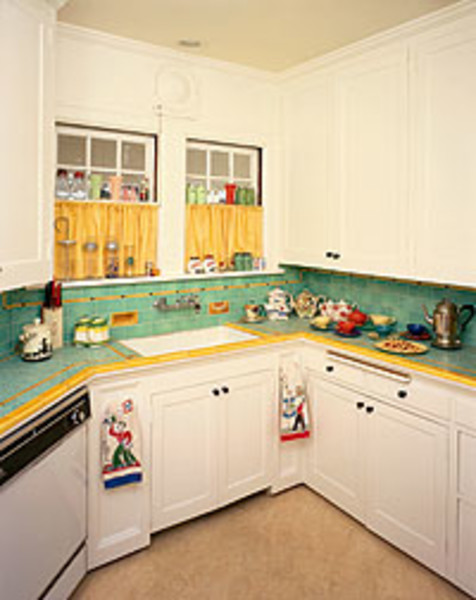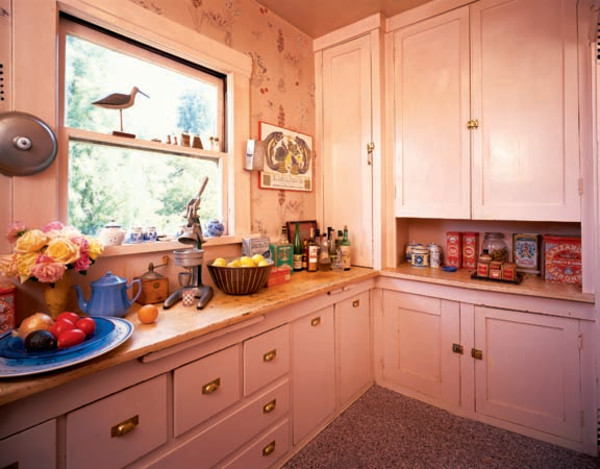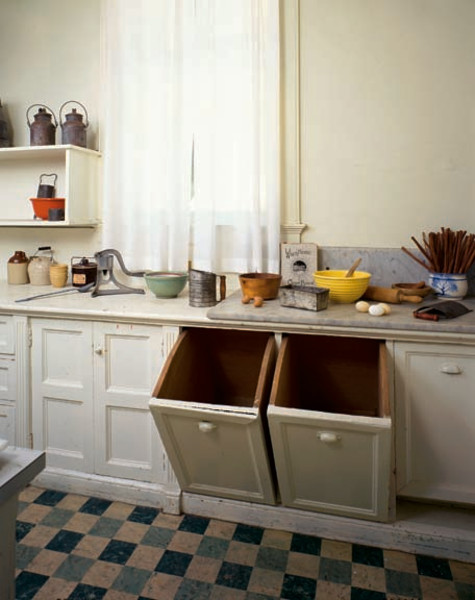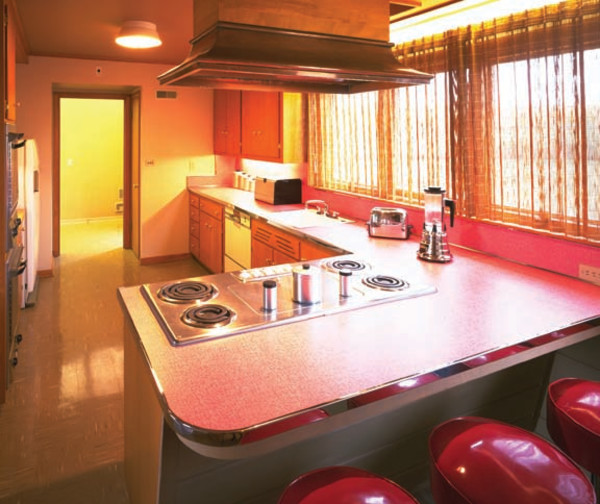A less common countertop material, tile allowed for great expression and color combinations, such as the decor in this circa-1940 kitchen, and was appreciated for its practicality because damaged tiles could be replaced individually. (Photo: Linda Svendsen)
These days, the only kitchen element used more often than the microwave is your countertop; you can never have enough of it. It’s where you follow recipes, chop, stir and mix, but also where you pay bills, take messages, and help with homework. Counters must be attractive and resilient, unfazed by heat, knife jabs, and countless spills. Modern countertops, such as those made of solid acrylic resin, are popular because they hold up so well, but if you live in a historic house, they can look odd and out of place.
Thankfully, traditional countertop materials are still widely available and can help you create a warm and historically appropriate work surface that can weather modern demands. The problem is that there are so many traditional materials available today that choosing an appropriate countertop for your kitchen can be the most challenging design decision you make. Stone, wood, steel, tile, and plastic laminates are all viable options, but each has strengths and weaknesses that must be carefully considered.
Wood
The universal building material in North America has always been the most common natural countertop material and is appropriate in almost every era of house. The earliest wood counters were wide boards, usually softwood but also hardwood. By the early 20th century, wood was also popular as butcher block (strips joined mechanically or with adhesive to make a solid surface). A butcher-block counter is highly practical because it can be used as a cutting surface.
These counters in a butler’s pantry in Berkeley, California, are original to the house and endured a coat of pink paint during the 1950s. (Photo: Linda Svendsen)
Because wood is porous, counters must be kept clean and properly maintained. Wood can be particularly problematic around the sink and stove, where it is exposed to water, grease, and heat. As butcher block and other wood counters wear, often they can be easily refurbished with sanding and planing, and an application of lemon juice or diluted chlorine bleach can lighten stains. If they are not used as a cutting surface, wide-board counters can be clear finished; food-service-safe coatings, such as salad bowl finish, are an excellent choice.
Tile
Beginning in the late 19th century, ceramic tile was often used as a backsplash and sometimes as a countertop material valued for its durability, artful beauty, and affordability. Today’s choices include glazed tiles with a high-gloss surface and unglazed tiles, such as quarry tiles. The downside of tile was and is that it can crack, and the grout can get dirty or spall out. If glass or ceramic dishes fall on tile, it will often break. Some tiles are more vulnerable than others: Glazed tile scratches easily; quarry tile can soak up spills and moisture; and decorative tile may be too delicate to use for anything other than a backsplash. Most of the problems related to tile countertops are a result of improper bedding, so of all the traditional countertop materials, the installation of tile surfaces may be the trickiest. On the plus side, damaged tiles can be replaced individually instead of the entire counter needing to be redone.
Stone
Marble’s cool, smooth surface was long considered the ideal place for making pastry, which explains the positioning of this marble slab atop the built-in sugar and flour bins. (Photo: Linda Svendsen)
Historically, stone was a sturdy and beautiful counter material but somewhat rare. Still, it wasn’t unusual for large kitchens to have a marble counter area because marble’s smooth, cool surface was ideal for making bread, pastry, and sweets. Today, marble, soapstone, slate, and granite are all widely used in period kitchens.
Soapstone, first marketed for kitchens in the mid-19th century, is smooth and yet rugged, impervious to nearly all substances and chemicals. Slate is widely available in a range of thicknesses and in two general finishes: polished like soapstone and natural. Finally, granite-the most expensive type of stone used for counters-is heralded for its strength and elegance.
The drawback to stone is that it is more porous than one might expectÑmarble, for instance, is prone to stains and etching from acidic foods such as tomatoesÑand must be sealed to prevent cracks and stains from setting in. Because of their weight, stone counters must be carefully supported, and base cabinets require the structural capacity to hold them. Stone is also pretty expensive to install, so some traditional homeowners might elect to use marble or granite slabs in just one section of the kitchen. Another option is to use stone tiles, which combine the look of a stone countertop with the cost-effectiveness and ease of replacement of ceramic tiles.
Metal
Sheet metal was a fixture in many kitchens in the late-19th century, when homeowners pumped water into wet and dry sinks lined with copper or nickel silver (an alloy of copper, nickel, and zinc). Metal soon made the progression from sinks to countertops of zinc, tin, nickel, or galvanized iron. By the 1920s and ’30s, a copper and nickel alloy called Monel became popular for counters and cabinets alike, thanks to a popular advertising campaign. Another early century option was enameled metal, which had an opaque coating fused to iron or steel that allowed homeowners to experiment with a range of colors while enjoying the strength of metal.
By the 1950s, however, Monel and other metals had been replaced by stainless steel as a popular counter alternative. Proponents of stainless-steel kitchens laud the material’s near indestructibility and its ease of use and maintenance. Although most people now associate stainless steel with high-tech professional kitchens, it is perfectly appropriate for a mid-20th-century house. While stainless steel can show cuts and spots over time, buffing often can reduce those imperfections.
Laminates
Laminates were a breakthrough in durability and stain resistance, and also came in great colors, such as this red linen Formica pattern from the 1950s All-Electric House, a model home built by the Kansas City Power and Lighting Co. (Photo: Courtesy The Johnson County Museum)
Plastic laminates, such as Formica, have been around for more than 50 years and can be a delightful option for a mid-century home. Laminates are widely known for their easy cleaning, decorative beauty, and resistance to water and stains, and now are easy to find in a host of period patterns. Formica, for example, was recently reissued in its iconic Boomerang pattern, and Wilsonart can custom-replicate any pattern. Laminates suit older houses, too, especially if the material is detailed to resemble more traditional choices such as wood or stone. Installation makes a difference in how traditional synthetics appear. Most modern installations use a self-edge treatment in which a strip of material is affixed to the front edge of the countertop. Counters from the 1940s and ’50s, though, often used metal edging, which can be used today for a period look.
Since the development of the modern kitchen, counters have been an important unifying element, visually and physically tying kitchens together. Weighing your decorative needs against a material’s strengths and history will help you avoid making a counterproductive kitchen installation. Fortunately, there’s an array of traditional materials to choose from for today’s countertops.







